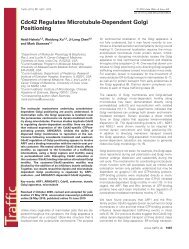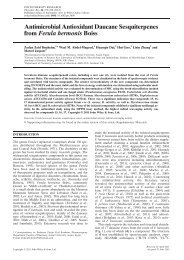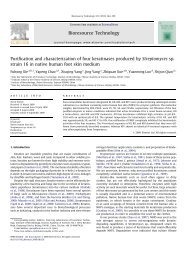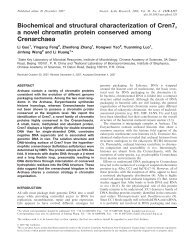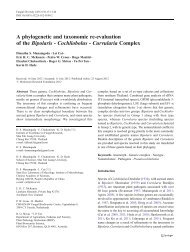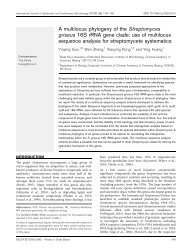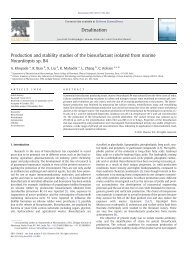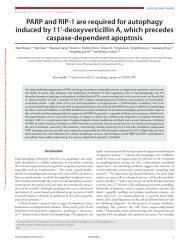Expression of cefF signiWcantly decreased deacetoxycephalosporin ...
Expression of cefF signiWcantly decreased deacetoxycephalosporin ...
Expression of cefF signiWcantly decreased deacetoxycephalosporin ...
You also want an ePaper? Increase the reach of your titles
YUMPU automatically turns print PDFs into web optimized ePapers that Google loves.
J Ind Microbiol Biotechnol<br />
Acknowledgments We thank Pr<strong>of</strong>. Xingzhong Liu (Institute <strong>of</strong><br />
Microbiology, CAS) for providing plasmid pAg1-H3 and A. tumefaciens<br />
strain AGL-1. We thank Dr. Jinwei Ren and Dr. Wenzhao Wang<br />
(Institute <strong>of</strong> Microbiology, CAS) for performing the analytical assay <strong>of</strong><br />
LC–MS. This work was supported by the Knowledge Innovation Program<br />
<strong>of</strong> the Chinese Academy <strong>of</strong> Sciences (Grant No. KSCX2-EW-J-6)<br />
and the Ministry <strong>of</strong> Science and Technology <strong>of</strong> China (Grant No.<br />
2010ZX09401-403).<br />
References<br />
1. Abraham EP, Newton GG (1961) The structure <strong>of</strong> cephalosporin<br />
C. Biochem J 79:377–393<br />
2. An Y, Yang J, Xu X, Liu G (2009) Construct cosmid libraries by<br />
isolating large genomic DNA fragments from Monascus ruber.<br />
Wei Sheng Wu Xue Bao 49(10):1385–1388<br />
3. Baker BJ, Dotzlaf JE, Yeh WK (1991) Deacetoxycephalosporin C<br />
hydroxylase <strong>of</strong> Streptomyces clavuligerus. PuriWcation, characterization,<br />
bifunctionality, and evolutionary implication. J Biol Chem<br />
266:5087–5093<br />
4. Bundock P, den Dulk-Ras A, Beijersbergen A, Hooykaas PJ<br />
(1995) Trans-kingdom T-DNA transfer from Agrobacterium tumefaciens<br />
to Saccharomyces cerevisiae. EMBO J 14:3206–3214<br />
5. Campoy S, Pérez F, Martín F, Gutiérrez S, Liras P (2003) Stable<br />
transformants <strong>of</strong> the azaphilone pigment-producing Monascus<br />
purpureus obtained by protoplast transformation and Agrobacterium-mediated<br />
DNA transfer. Curr Genet 43:447–452<br />
6. Chiang JB (1998) Genetic engineering approach to reduce undesirable<br />
by-products in cephalosporin C fermentation. J Ind Microbiol<br />
Biot 20:344–353<br />
7. Coque JJ, Martín JF, Liras P (1993) Characterization and expression<br />
in Streptomyces lividans <strong>of</strong> cefD and cefE genes from Nocardia<br />
lactamdurans: the organization <strong>of</strong> the cephamycin gene cluster<br />
diVers from that in Streptomyces clavuligerus. Mol Gen Genet<br />
236(2–3):453–458<br />
8. de Groot MJA, Bundock P, Hooykaas PJJ, Beijersbergen AGM<br />
(1998) Agrobacterium tumefaciens-mediated transformation <strong>of</strong><br />
Wlamentous fungi. Nat Biotechnol 16:839–842<br />
9. DeModena JA, Gutierrez S, Velasco J, Fernandez FJ, Fachini RA,<br />
Galazzo JL, Hughes DE, Martin JF (1993) The production <strong>of</strong> cephalosporin<br />
C by Acremonium chrysogenum is improved by the<br />
intracellular expression <strong>of</strong> a bacterial hemoglobin. Biotechnology<br />
(NY) 11:926–929<br />
10. Dityatkin SY, Lisovskaya KV, Panzhava NN, Iliashenko BN<br />
(1972) Frozen-thawed bacteria as recipients <strong>of</strong> isolated coliphage<br />
DNA. Biochim Biophys Acta 281:319–323<br />
11. Dotzlaf JE, Yeh WK (1987) CopuriWcation and characterization <strong>of</strong><br />
<strong>deacetoxycephalosporin</strong> C synthetase/hydroxylase from Cephalosporium<br />
acremonium. J Bacteriol 169:1611–1618<br />
12. Gutierrez S, Diez B, Montenegro E, Martin JF (1991) Characterization<br />
<strong>of</strong> the Cephalosporium acremonium pcbAB gene encoding<br />
alpha-aminoadipyl-cysteinyl-valine synthetase, a large multidomain<br />
peptide synthetase: linkage to the pcbC gene as a cluster <strong>of</strong><br />
early cephalosporin biosynthetic genes and evidence <strong>of</strong> multiple<br />
functional domains. J Bacteriol 173:2354–2365<br />
13. Gutiérrez S, Velasco J, Fernandez FJ, Martín JF (1992) The cefG<br />
gene <strong>of</strong> Cephalosporium acremonium is linked to the cefEF gene<br />
and encodes a deacetylcephalosporin C acetyltransferase closely<br />
related to homoserine O-acetyltransferase. J Bacteriol 174:3056–<br />
3064<br />
14. Gutierrez S, Velasco J, Marcos AT, Fernandez FJ, Fierro F, Barredo<br />
JL, Diez B, Martin JF (1997) <strong>Expression</strong> <strong>of</strong> the cefG gene is<br />
limiting for cephalosporin biosynthesis in Acremonium chrysogenum.<br />
Appl Microbiol Biotechnol 48:606–614<br />
15. H<strong>of</strong>gen R, Willmitzer L (1988) Storage <strong>of</strong> competent cells for<br />
Agrobacterium transformation. Nucleic Acids Res 16:9877<br />
16. Holsters M, de Waele D, Depicker A, Messens E, van Montagu M,<br />
Schell J (1978) Transfection and transformation <strong>of</strong> Agrobacterium<br />
tumefaciens. Mol Gen Genet 163:181–187<br />
17. Hooykaas PJJ, Roobol C, Schilperoort RA (1979) Regulation <strong>of</strong><br />
the transfer <strong>of</strong> TI plasmids <strong>of</strong> Agrobacterium tumefaciens. J Gen<br />
Microbiol 110:99–109<br />
18. Kang S, Metzenberg RL (1993) Insertional mutagenesis in Neurospora<br />
crassa: cloning and molecular analysis <strong>of</strong> the preg+ gene<br />
controlling the activity <strong>of</strong> the transcriptional activator NUC-1.<br />
Genetics 133:193–202<br />
19. Kovacevic S, Miller JR (1991) Cloning and sequencing <strong>of</strong> the<br />
beta-lactam hydroxylase gene (<strong>cefF</strong>) from Streptomyces clavuligerus:<br />
gene duplication may have led to separate hydroxylase and<br />
expandase activities in the actinomycetes. J Bacteriol 173:398–400<br />
20. Liras P, Demain AL (2009) Chapter 16. Enzymology <strong>of</strong> beta-lactam<br />
compounds with cephem structure produced by actinomycete.<br />
Methods Enzymol 458:401–429<br />
21. Liu G, Casqueiro J, Banuelos O, Cardoza RE, Gutierrez S, Martin<br />
JF (2001) Targeted inactivation <strong>of</strong> the mecB gene, encoding cystathionine-gamma-lyase,<br />
shows that the reverse transsulfuration<br />
pathway is required for high-level cephalosporin biosynthesis in<br />
Acremonium chrysogenum C10 but not for methionine induction<br />
<strong>of</strong> the cephalosporin genes. J Bacteriol 183:1765–1772<br />
22. Martin JF, Ullan RV, Casqueiro J (2004) Novel genes involved in<br />
cephalosporin biosynthesis: the three-component isopenicillin N<br />
epimerase system. Adv Biochem Eng Biotechnol 88:91–109<br />
23. Matsuda A, Sugiura H, Matsuyama K, Matsumoto H, Ichikawa S,<br />
Komatsu K (1992) Cloning and disruption <strong>of</strong> the cefG gene encoding<br />
acetyl coenzyme A: deacetylcephalosporin C O-acetyltransferase<br />
from Acremonium chrysogenum. Biochem Biophys Res<br />
Commun 186:40–46<br />
24. Newton GG, Abraham EP (1956) Isolation <strong>of</strong> cephalosporin C, a<br />
penicillin-like antibiotic containing D-alpha-aminoadipic acid.<br />
Biochem J 62:651–658<br />
25. Samson SM, Dotzlaf JE, Slisz ML, Becker GW, Van Frank RM,<br />
Veal LE, Yeh WK, Miller JR, Queener SW, Ingolia TD (1987)<br />
Cloning and expression <strong>of</strong> the fungal expandase/hydroxylase gene<br />
involved in cephalosporin biosynthesis. Nat Biotechnol 5:1207–<br />
1214<br />
26. Schmitt EK, HoV B, Kuck U (2004) Regulation <strong>of</strong> cephalosporin<br />
biosynthesis. Adv Biochem Engin/Biotechnol 88:1–43<br />
27. Sen BKB (2006) Antibiotics business: a glimpse. Indian J Biotechnol<br />
5:471–476<br />
28. Shen YQ, Wolfe S, Demain AL (1986) Levels <strong>of</strong> isopenicillin N<br />
synthetase and <strong>deacetoxycephalosporin</strong> C synthetase. Nat Biotechnol<br />
4:61–64<br />
29. Skatrud PL, Tietz AJ, Ingolia TD, Cantwell CA, Fisher DL, Chapman<br />
JL, Queener SW (1989) Use <strong>of</strong> recombinant DNA to improve<br />
production <strong>of</strong> cephalosporin C by Cephalosporium acremonium.<br />
Nat Biotechnol 7:477–485<br />
30. Ullan RV, Casqueiro J, Banuelos O, Fernandez FJ, Gutierrez S,<br />
Martin JF (2002) A novel epimerization system in fungal secondary<br />
metabolism involved in the conversion <strong>of</strong> isopenicillin N into<br />
penicillin N in Acremonium chrysogenum. J Biol Chem<br />
277:46216–46225<br />
31. Ullan RV, Liu G, Casqueiro J, Gutierrez S, Banuelos O, Martin JF<br />
(2002) The cefT gene <strong>of</strong> Acremonium chrysogenum C10 encodes a<br />
putative multidrug eZux pump protein that <strong>signiWcantly</strong> increases<br />
cephalosporin C production. Mol Genet Genomics 267:673–683<br />
32. Zhang A, Lu P, Dahl-Roshak AM, Paress PS, Kennedy S, Tkacz<br />
JS, An Z (2003) EYcient disruption <strong>of</strong> a polyketide synthase gene<br />
(pks1) required for melanin synthesis through Agrobacteriummediated<br />
transformation <strong>of</strong> Glarea lozoyensis. Mol Genet Genomics<br />
268:645–655<br />
123





